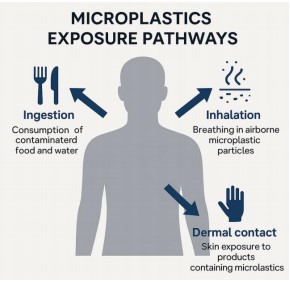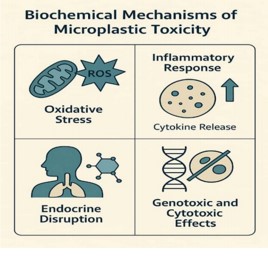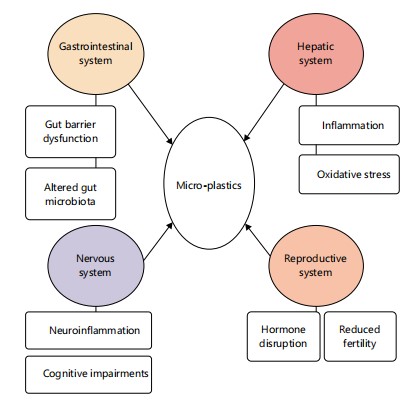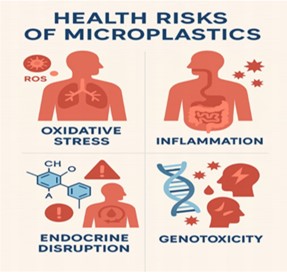Biochemical Effects of Microplastics on Human Health: A Comprehensive Review
| Received 12 Apr, 2025 |
Accepted 18 Jun, 2025 |
Published 19 Jun, 2025 |
Microplastics (MPs), plastic particles less than 5 mm in size, have emerged as pervasive environmental contaminants with significant biochemical implications for human health. This review systematically explores the pathways through which MPs enter the human body, primarily via ingestion, inhalation, and dermal contact, and their subsequent biodistribution to vital organs, including the lungs, liver, kidneys, gastrointestinal tract, brain, and reproductive organs. Once internalized, MPs provoke complex biochemical responses such as oxidative stress, inflammation, endocrine disruption, and genotoxicity, contributing to systemic toxicity and chronic conditions like metabolic syndrome, neurodegenerative diseases, immune dysregulation, reproductive dysfunctions, and cancer. Organ-specific impacts are detailed, showing disruptions in gut microbiota, hepatic lipid metabolism, renal filtration, and neurochemical signaling. The review further identifies critical biochemical biomarkers, including elevated cytokines, lipid peroxidation products, and hormonal fluctuations, as early indicators of MP-induced toxicity. It assesses current risk evaluation models and emphasizes the urgent need for standardized detection methods, biomonitoring frameworks, and computational modeling to predict human health outcomes. Preventive and mitigative strategies are discussed, spanning regulatory bans on microbeads, advancements in wastewater treatment, and international policy coordination. The review concludes by advocating for global collaboration in research and policy development to combat the growing threat of microplastics, while calling for more longitudinal studies to elucidate their long-term human health effects.
| Copyright © 2025 Anih et al. This is an open-access article distributed under the Creative Commons Attribution License, which permits unrestricted use, distribution, and reproduction in any medium, provided the original work is properly cited. |
INTRODUCTION
The rising prevalence of microplastics (MPs), plastic particles less than 5 mm in size, in various ecosystems has garnered significant global attention due to their persistence, pervasiveness, and potential to adversely affect human health1-3. As plastic production exceeds 350 million tons annually, the degradation and fragmentation of these materials result in MPs infiltrating terrestrial, aquatic, and atmospheric compartments4,5. Consequently, MPs have become an unavoidable component of the human exposome, entering the body through ingestion of contaminated food and beverages, inhalation of airborne particles, and, to a lesser extent, dermal absorption6,7. Recent reports have identified MPs in human stool, placenta, lung, liver, and blood, highlighting their capacity to breach biological barriers and accumulate in critical tissues8-11.

|
Several studies have demonstrated the potential for MPs to induce significant biochemical disruptions once internalized. These disruptions include oxidative stress, inflammation, endocrine interference, and genotoxicity, mechanisms that are implicated in chronic diseases such as cancer, metabolic syndrome, neurodegeneration, reproductive dysfunction, and immune dysregulation12-21. Animal models exposed to MPs have shown increased levels of malondialdehyde, decreased antioxidant enzyme activities, elevated cytokines, and hormonal imbalances, suggesting a multifaceted assault on human biochemistry14-19. Furthermore, MPs often act as carriers for hazardous chemicals like phthalates, bisphenol A, and persistent organic pollutants, compounding their toxic potential17,18.
Although studies have begun to characterize the molecular mechanisms of MP toxicity, gaps remain in understanding dose-response relationships, long-term health effects, and the role of particle size, composition, and shape in toxicity. Moreover, inconsistencies in sampling, detection, and quantification methods have hindered the development of standardized biomonitoring and risk assessment protocols. While recent research has explored the impact of MPs on specific organs, such as the gastrointestinal system, liver, kidneys, brain, and reproductive organs, comprehensive frameworks that integrate organ-specific effects with underlying biochemical pathways are still evolving22-29.
This review aims to synthesize current knowledge on the biochemical impacts of MPs on human health, with a focus on systemic and organ-specific toxicity, relevant biomarkers, and molecular mechanisms. By consolidating findings across recent literature, this study intends to provide a holistic overview of MP-induced biochemical alterations and identify critical gaps for future investigation. The purpose of this review is to advance understanding of the biochemical mechanisms underlying MP toxicity, support the development of predictive models for human health outcomes, and inform regulatory policies and public health strategies targeting microplastic exposure.
Figure 1 illustrates the primary routes of microplastic exposure in humans, including ingestion (via contaminated food and water), inhalation (airborne fibers from synthetic materials and indoor dust), and dermal contact (via cosmetics and textiles). Each route leads to potential absorption and distribution to various organs such as the lungs, liver, intestines, bloodstream, and reproductive organs. The image emphasizes the systemic reach of microplastics once internalized. These exposure routes explain how microplastics traverse environmental compartments to enter the human body, highlighting the importance of monitoring both environmental sources and product usage1-7.
BIOCHEMICAL MECHANISMS OF MICROPLASTIC TOXICITY
Figure 2 illustrates four interconnected pathways, oxidative stress, inflammation, endocrine disruption, and genotoxicity, through which microplastics exert harmful effects on human health. Upon entering the body, microplastics and their associated pollutants induce excessive reactive oxygen species (ROS) production, overwhelming antioxidant defenses, and damaging cellular components. This oxidative stress activates inflammatory signaling pathways, leading to the release of pro-inflammatory cytokines and chronic tissue inflammation. Concurrently, microplastics leach endocrine-disrupting chemicals like bisphenol A and phthalates, which interfere with hormonal signaling and regulation, contributing to reproductive and metabolic disorders. Additionally, microplastics and their by-products can cause direct DNA damage, resulting in chromosomal abnormalities, apoptosis, and increased cancer risk. Together, these biochemical pathways explain the systemic toxicity of microplastics, highlighting their multi-organ impact and the urgent need for targeted public health interventions1,12-21.
Oxidative stress and reactive oxygen species (ROS): Microplastics induce oxidative stress by generating reactive oxygen species (ROS), overwhelming the antioxidant defense systems of cells12. This imbalance can damage cellular macromolecules, including DNA, proteins, and lipids, triggering apoptosis and inflammatory pathways13. For example, polystyrene microplastics have been shown to increase malondialdehyde (MDA) levels and decrease superoxide dismutase (SOD) activity in exposed rodent models14. A similar trend was observed in a recent soil study, where polystyrene showed elevated persistence even after environmental exposure, indicating its resistance to degradation and sustained biochemical activity.
Inflammatory responses: Inflammation is a common response to the presence of MPs, particularly in the lungs and gastrointestinal tract. Microplastics activate pro-inflammatory cytokines such as IL-6 and TNF-α, leading to chronic inflammation15. Histological analysis of exposed animal tissues reveals lymphocytic infiltration and epithelial damage16.
Endocrine disruption: Microplastics act as vectors for endocrine-disrupting chemicals (EDCs) such as phthalates and bisphenol A (BPA), which are often used in plastic manufacturing17. These compounds mimic hormonal structures and disrupt pathways involving estrogen, testosterone, and thyroid hormones18. This has been linked to reduced fertility, altered puberty timing, and developmental abnormalities19. It is also noteworthy that degraded products of MPs, formed under sunlight or temperature-driven exposure in soil environments, may possess different endocrine activity profiles than their parent compounds, suggesting that environmental conditions can influence the biochemical nature of MPs before human exposure.

|
Genotoxic and cytotoxic effects: Laboratory studies show that MPs can induce DNA strand breaks and chromosomal aberrations. This genotoxicity is often associated with oxidative damage and internalization of particles into cells20. Chronic exposure may increase the risk of cancer development21.
ORGAN-SPECIFIC BIOCHEMICAL EFFECTS
Gastrointestinal system: Microplastics disrupt the gut barrier, increase intestinal permeability (“leaky gut”), and alter the gut microbiota composition22,23. Animal models exposed to MPs show increased levels of lipopolysaccharide (LPS) and decreased beneficial bacterial populations, contributing to inflammation and metabolic dysregulation23. Furthermore, environmental studies have demonstrated that UV exposure can lead to differential degradation rates of microplastic types, which in turn may influence their chemical profiles and toxic effects upon entering the human body.
This 2D diagram presents the biochemical impacts of microplastics on various human organs (Fig. 3). It maps how absorbed microplastics affect: Lungs (via oxidative stress and inflammation), Liver (altered lipid metabolism and detoxification), Intestines (gut dysbiosis and epithelial disruption), Kidneys (nephrotoxicity and microplastic accumulation), Reproductive organs (endocrine disruption), Brain (neurotoxicity and behavioral alterations), Arrows indicate pathways of translocation and accumulation, while side annotations describe the key molecular consequences, including ROS generation, cytokine release, endocrine interference, and mitochondrial dysfunction12,14,16,22,23. This figure visualizes the multisystemic toxicity of microplastics and their biochemical interference mechanisms at the organ and cellular levels.
Liver and kidneys: Hepatic accumulation of MPs results in fatty liver, necrosis, and increased liver enzyme levels (ALT and AST)24. The MPs may also accumulate in renal tissues, leading to glomerular and tubular dysfunctions, as seen in rodent models25.
Nervous system: Emerging data suggests MPs may cross the blood-brain barrier, leading to neurotoxicity and behavioral changes in animal studies26. Mechanisms involve microglial activation, oxidative stress, and neurotransmitter dysregulation27.

|
Reproductive system: The MPs have been shown to reduce sperm quality, disrupt ovarian function, and impair fetal development in animal models28. Exposure during gestation has been associated with altered hormone levels and fetal growth restriction29-32.
BIOMARKERS, RISK ASSESSMENT, AND PREVENTIVE MEASURES
Risk assessment strategies: Risk assessment for microplastic exposure involves a multidisciplinary approach integrating environmental monitoring, toxicological data, and population-level health surveillance. One major challenge in this domain is the lack of standardized methods for quantifying microplastics in biological tissues and determining dose-response relationships. Studies have proposed the use of computational modeling and extrapolation from animal data to estimate human exposure thresholds33. Furthermore, incorporating biomarkers and omics technologies (e.g., transcriptomics, proteomics) into risk assessment frameworks can help establish causal relationships between exposure and disease outcomes34.
Biochemical biomarkers of microplastic toxicity: Several biochemical biomarkers have been identified in response to microplastic exposure, which can serve as early indicators of toxicity.
Oxidative stress biomarkers: Increased levels of malondialdehyde (MDA), a lipid peroxidation product, and depletion of antioxidants such as glutathione (GSH) indicate oxidative damage35. The persistence of specific microplastics such as polyamide and polyethylene in soil under thermal and UV stress also correlates with heightened oxidative markers, as shown in recent environmental degradation studies.
Inflammatory markers: Elevated levels of cytokines like TNF-α, IL-6, and CRP have been reported following microplastic exposure in experimental models36.
Endocrine disruption indicators: Alterations in estrogen, testosterone, and thyroid hormone levels have been observed, particularly with microplastics leaching bisphenol A (BPA) and phthalates37.
Genotoxicity markers: The DNA fragmentation, micronucleus formation, and comet assay outcomes suggest genomic instability following microplastic accumulation38.
These biomarkers provide a foundation for developing screening tools and early warning systems for microplastic-related health risks.
Figure 4 demonstrates that microplastics are not inert; instead, they pose serious biological threats through oxidative, inflammatory, hormonal, and genetic pathways. These findings emphasize the importance of regulating microplastic exposure and investigating long-term human health outcomes27-30.
Preventive and mitigative strategies: Mitigation of microplastic-related risks involves a combination of regulatory, technological, and lifestyle interventions. Regulatory efforts include banning microbeads in cosmetics, improving waste management systems, and enforcing extended producer responsibility39. On the technological front, advanced filtration systems in wastewater treatment plants, biodegradable polymer alternatives, and innovations in packaging can significantly reduce microplastic release40. From an individual perspective, reducing consumption of single-use plastics, opting for natural fiber clothing, and advocating for policy reforms are essential actions.

|
Global initiatives and future directions: International organizations such as the World Health Organization (WHO), United Nations Environment Programme (UNEP), and European Commission are initiating global frameworks to monitor and reduce microplastic pollution. Collaborative efforts like the Plastic Health Coalition and scientific panels have called for more comprehensive research into the long-term effects of microplastics on human health41-43. Future research should focus on establishing chronic exposure models, exploring epigenetic impacts, and integrating microplastic exposure assessment into global health surveillance programs42.
CONCLUSION
Microplastics are pervasive in modern life and have been confirmed to enter and accumulate within human tissues. Once inside the body, MPs can initiate oxidative stress, inflammation, endocrine disruption, and genotoxic effects, leading to organ-specific damage. Their biochemical effects are not only due to the particles themselves but also due to the cocktail of adsorbed chemicals and additives they carry. As scientific understanding grows, it becomes clear that urgent actions are needed, both at the individual and governmental levels, to limit exposure and mitigate long-term health consequences. The biochemical implications of MPs pose a pressing public health challenge and warrant robust interdisciplinary research and global policy coordination.
SIGNIFICANCE STATEMENT
This comprehensive review addresses the urgent and growing concern of microplastic (MP) exposure and its biochemical implications for human health. By synthesizing current evidence, the article delineates key mechanistic pathways, oxidative stress, inflammation, endocrine disruption, and genotoxicity, linking MP exposure to a spectrum of chronic diseases. It also identifies critical organ-specific effects and biochemical biomarkers relevant for early detection and risk evaluation. The findings contribute meaningfully to the evolving field of environmental toxicology by highlighting research gaps, advocating for standardized biomonitoring frameworks, and supporting the development of predictive models. The article offers timely insights that align with global public health priorities and regulatory interests, making it a valuable resource for advancing scientific dialogue and policy action on microplastic pollution.
REFERENCES
- Geyer, R., J.R. Jambeck and K.L. Law, 2017. Production, use, and fate of all plastics ever made. Sci. Adv., 3.
- Gigault, J., A. ter Halle, M. Baudrimont, P.Y. Pascal and F. Gauffre et al., 2018. Current opinion: What is a nanoplastic? Environ. Pollut., 235: 1030-1034.
- Bergmann, M., L. Gutow and M. Klages, 2015. Marine Anthropogenic Litter. Springer International Publishing, Switzerland, ISBN: 978-3-319-37653-0, Pages: 447.
- Barboza, L.G.A., A.D. Vethaak, B.R.B.O. Lavorante, A.K. Lundebye and L. Guilhermino, 2018. Marine microplastic debris: An emerging issue for food security, food safety and human health. Mar. Pollut. Bull., 133: 336-348.
- Vianello, A., R.L. Jensen, L. Liu and J. Vollertsen, 2019. Simulating human exposure to indoor airborne microplastics using a breathing thermal manikin. Sci. Rep., 9.
- Prata, J.C., 2018. Microplastics in wastewater: State of the knowledge on sources, fate and solutions. Mar. Pollut. Bull., 129: 262-265.
- Cox, K.D., G.A. Covernton, H.L. Davies, J.F. Dower, F. Juanes and S.E. Dudas, 2019. Human consumption of microplastics. Environ. Sci. Technol., 53: 7068-7074.
- Schwabl, P., S. Köppel, P. Königshofer, T. Bucsics, M. Trauner, T. Reiberger and B. Liebmann, 2019. Detection of various microplastics in human stool: A prospective case series. Ann. Intern. Med., 171: 453-457.
- Ragusa, A., A. Svelato, C. Santacroce, P. Catalano and V. Notarstefano et al., 2021. Plasticenta: First evidence of microplastics in human placenta. Environ. Int., 146.
- Jenner, L.C., J.M. Rotchell, R.T. Bennett, M. Cowen, V. Tentzeris and L.R. Sadofsky, 2022. Detection of microplastics in human lung tissue using μFTIR spectroscopy. Sci. Total Environ., 831.
- Leslie, H.A., M.J.M. van Velzen, S.H. Brandsma, A.D. Vethaak, J.J. Garcia-Vallejo and M.H. Lamoree, 2022. Discovery and quantification of plastic particle pollution in human blood. Environ. Int., 163.
- Hirt, N. and M. Body-Malapel, 2020. Immunotoxicity and intestinal effects of nano- and microplastics: A review of the literature. Part. Fibre Toxicol., 17.
- Campanale, C., C. Massarelli, I. Savino, V. Locaputo and V.F. Uricchio, 2020. A detailed review study on potential effects of microplastics and additives of concern on human health. Int. J. Environ. Res. Public Health, 17.
- Lu, L., Z. Wan, T. Luo, Z. Fu and Y. Jin, 2018. Polystyrene microplastics induce gut microbiota dysbiosis and hepatic lipid metabolism disorder in mice. Sci. Total Environ., 631-632: 449-458.
- Fournier, S.B., J.N. D’Errico, D.S. Adler, S. Kollontzi and M.J. Goedken et al., 2020. Nanopolystyrene translocation and fetal deposition after acute lung exposure during late-stage pregnancy. Part. Fibre Toxicol., 17.
- Deng, Y., Y. Zhang, B. Lemos and H. Ren, 2017. Tissue accumulation of microplastics in mice and biomarker responses suggest widespread health risks of exposure. Sci. Rep., 7.
- Talsness, C.E., A.J.M. Andrade, S.N. Kuriyama, J.A. Taylor and F.S. vom Saal, 2009. Components of plastic: Experimental studies in animals and relevance for human health. Philos. Trans. R. Soc. B, 364: 2079-2096.
- Lee, H.J., S. Chattopadhyay, E.Y. Gong, R.S. Ahn and K. Lee, 2003. Antiandrogenic effects of bisphenol A and nonylphenol on the function of androgen receptor. Toxicol. Sci., 75: 40-46.
- Chen, Q., M. Gundlach, S. Yang, J. Jiang, M. Velki, D. Yin and H. Hollert, 2017. Quantitative investigation of the mechanisms of microplastics and nanoplastics toward zebrafish larvae locomotor activity. Sci. Total Environ., 584-585: 1022-1031.
- Liu, Q., Z. Chen, Y. Chen, F. Yang, W. Yao and Y. Xie, 2021. Microplastics and nanoplastics: Emerging contaminants in food. J. Agric. Food. Chem., 69: 10450-10468.
- Lim, X., 2021. Microplastics are everywhere-but are they harmful? Nature, 593: 22-25.
- Jin, Y., J. Xia, Z. Pan, J. Yang, W. Wang and Z. Fu, 2018. Polystyrene microplastics induce microbiota dysbiosis and inflammation in the gut of adult zebrafish. Environ. Pollut., 235: 322-329.
- Xu, R., J.W. Cao, H.L. Lv, Y. Geng and M.Y. Guo, 2024. Polyethylene microplastics induced gut microbiota dysbiosis leading to liver injury via the TLR2/NF-κB/NLRP3 pathway in mice. Sci. Total Environ., 917.
- Wu, B., X. Wu, S. Liu, Z. Wang and L. Chen, 2019. Size-dependent effects of polystyrene microplastics on cytotoxicity and efflux pump inhibition in human Caco-2 cells. Chemosphere, 221: 333-341.
- Xu, M., G. Halimu, Q. Zhang, Y. Song and X. Fu et al., 2019. Internalization and toxicity: A preliminary study of effects of nanoplastic particles on human lung epithelial cell. Sci. Total Environ., 694.
- Prüst, M., J. Meijer and R.H.S. Westerink, 2020. The plastic brain: Neurotoxicity of micro- and nanoplastics. Part. Fibre Toxicol., 17.
- Sussarellu, R., M. Suquet, Y. Thomas, C. Lambert and C. Fabioux et al., 2016. Oyster reproduction is affected by exposure to polystyrene microplastics. Proc. Natl. Acad. Sci. U.S.A., 113: 2430-2435.
- Park, E.J., J.S. Han, E.J. Park, E. Seong and G.H. Lee et al., 2020. Repeated-oral dose toxicity of polyethylene microplastics and the possible implications on reproduction and development of the next generation. Toxicol. Lett., 324: 75-85.
- Li, J., K. Zhang and H. Zhang, 2018. Adsorption of antibiotics on microplastics. Environ. Pollut., 237: 460-467.
- Smith, M., D.C. Love, C.M. Rochman and R.A. Neff, 2018. Microplastics in seafood and the implications for human health. Curr. Environ. Health Rep., 5: 375-386.
- Xanthos, D. and T.R. Walker, 2017. International policies to reduce plastic marine pollution from single-use plastics (plastic bags and microbeads): A review. Mar. Pollut. Bull., 118: 17-26.
- Koelmans, A.A., P.E. Redondo-Hasselerharm, N.H.M. Nor and M. Kooi, 2020. Solving the nonalignment of methods and approaches used in microplastic research to consistently characterize risk. Environ. Sci. Technol., 54: 12307-12315.
- Prata, J.C., J.P. da Costa, I. Lopes, A.C. Duarte and T. Rocha-Santos, 2020. Environmental exposure to microplastics: An overview on possible human health effects. Sci. Total Environ., 702.
- Kögel, T., Ø. Bjorøy, B. Toto, A.M. Bienfait and M. Sanden, 2020. Micro- and nanoplastic toxicity on aquatic life: Determining factors. Sci. Total Environ., 709.
- Lee, A.G., S. Kang, H.J. Yoon, S. Im, S.J. Oh and Y.K. Pak, 2023. Polystyrene microplastics exacerbate systemic inflammation in high-fat diet-induced obesity. Int. J. Mol. Sci., 24.
- Wang, X., X.M. Ren, H. He, F. Li and K. Liua et al., 2023. Cytotoxicity and pro-inflammatory effect of polystyrene nano-plastic and micro-plastic on RAW264.7 cells. Toxicology, 484.
- Kuehr, S., R. Kaegi, D. Maletzki and C. Schlechtriem, 2021. Testing the bioaccumulation potential of manufactured nanomaterials in the freshwater amphipod Hyalella azteca. Chemosphere, 263.
- Anbumani, S. and P. Kakkar, 2018. Ecotoxicological effects of microplastics on biota: A review. Environ. Sci. Pollut. Res., 25: 14373-14396.
- Wright, S.L. and F.J. Kelly, 2017. Plastic and human health: A micro issue? Environ. Sci. Technol., 51: 6634-6647.
- van Sebille, E., C. Wilcox, L. Lebreton, N. Maximenko and B.D. Hardesty et al., 2015. A global inventory of small floating plastic debris. Environ. Res. Lett., 10.
- Pivokonsky, M., L. Cermakova, K. Novotna, P. Peer, T. Cajthaml and V. Janda, 2018. Occurrence of microplastics in raw and treated drinking water. Sci. Total Environ., 643: 1644-1651.
- Mason, S.A., V.G. Welch and J. Neratko, 2018. Synthetic polymer contamination in bottled water. Front. Chem., 6.
- Abah, M.A., O. Olawale, M. Timothy, N.C. Timothy and O.N. Oyibo et al., 2024. Effect of temperature on microplastic degradation in soil environment. Asian J. Sci. Technol. Eng. Art, 2: 677-691.
How to Cite this paper?
APA-7 Style
Anih,
D.C., Arowora,
A.K., Abah,
M.A., Ugwuoke,
K.C. (2025). Biochemical Effects of Microplastics on Human Health: A Comprehensive Review. Science International, 13(1), 27-34. https://doi.org/10.17311/sciintl.2025.27.34
ACS Style
Anih,
D.C.; Arowora,
A.K.; Abah,
M.A.; Ugwuoke,
K.C. Biochemical Effects of Microplastics on Human Health: A Comprehensive Review. Sci. Int 2025, 13, 27-34. https://doi.org/10.17311/sciintl.2025.27.34
AMA Style
Anih
DC, Arowora
AK, Abah
MA, Ugwuoke
KC. Biochemical Effects of Microplastics on Human Health: A Comprehensive Review. Science International. 2025; 13(1): 27-34. https://doi.org/10.17311/sciintl.2025.27.34
Chicago/Turabian Style
Anih, David, Chinonso, Adebisi Kayode Arowora, Moses Adondua Abah, and Kenneth Chinekwu Ugwuoke.
2025. "Biochemical Effects of Microplastics on Human Health: A Comprehensive Review" Science International 13, no. 1: 27-34. https://doi.org/10.17311/sciintl.2025.27.34

This work is licensed under a Creative Commons Attribution 4.0 International License.



